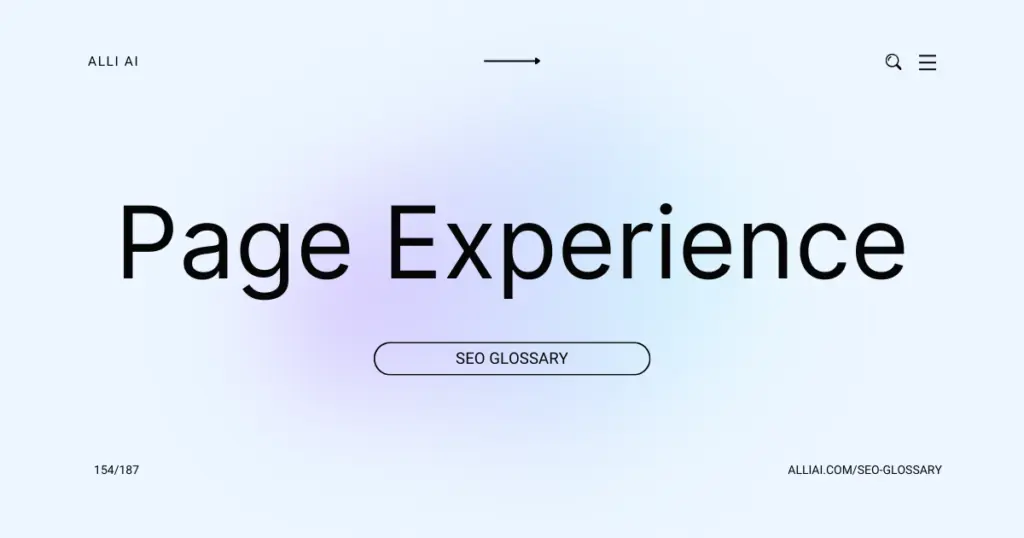What Does Page Experience Mean?
Page Experience is a set of metrics that Google uses to measure how users perceive the experience of interacting with a web page beyond its pure information value. It includes aspects such as how fast the page loads, how mobile-friendly it is, whether it runs on HTTPS, the presence of intrusive ads, and how stable the content is as it loads (preventing unexpected shifts on the page). These factors help determine a page’s usability and can impact its ranking in search results.
Where Does Page Experience Fit Into The Broader SEO Landscape?
Page Experience is a set of signals that measure how users perceive the experience of interacting with a web page beyond its pure information value. It includes Core Web Vitals, which are a set of real-world, user-centered metrics that quantify key aspects of the user experience. They measure dimensions of web usability such as load time, interactivity, and the stability of content as it loads.
Additionally, Page Experience encompasses mobile-friendliness, which ensures the page is optimized for mobile devices; safe-browsing, which checks for malicious or deceptive content; HTTPS-security, which secures the site’s connection through HTTPS; and intrusive interstitial guidelines, which ensures content accessibility.
In the broader SEO landscape, Page Experience influences a website’s ranking in search engine results pages (SERPs). Google, for instance, incorporates these metrics into its ranking algorithms, emphasizing the need for a responsive, stable, and accessible user experience. This holistic measure is intended to help sites focus on not only providing valuable content but also delivering it in a user-friendly manner to enhance overall user satisfaction and engagement, which in turn can lead to better rankings.
Real Life Analogies or Metaphors to Explain Page Experience
1. Concert Experience: Imagine attending a concert where the sound quality is excellent, the view is unobstructed, the seats are comfortable, and the staff is helpful. All these factors contribute to how much you enjoy the concert, regardless of how good the band is. Page Experience on a website is similar; it involves all the conditions like page speed, mobile-friendliness, and safe browsing that enhance how users interact with and appreciate the website, irrespective of the content quality.
2. Fine Dining: Dining at a high-end restaurant isn’t just about the food on your plate. It includes the ambiance, the service, the plating, and even the background music. Each element works together to create a memorable meal. Similarly, Page Experience in SEO encompasses various user-friendly aspects like quick loading times, interactive stability, and visual stability which culminate to make visiting a website a pleasant or unpleasant overall experience.
3. Navigating a Theme Park: When you visit a theme park, your overall experience isn’t just about the rides. It includes how easy it is to find each attraction, how long you wait in lines, how clean the park is, and how safe you feel. These supplementary experiences impact your overall satisfaction, much like how navigational ease, page speed, and security impact a user’s experience on a website.
How the Page Experience Functions or is Implemented?
1. Core Web Vitals: Measures user experience through three main metrics:
– Largest Contentful Paint (LCP): Measures loading performance; a good score is when the main content loads within 2.5 seconds of landing on the page.
– First Input Delay (FID): Assesses interactivity; aims for responsiveness within 100 milliseconds to user inputs.
– Cumulative Layout Shift (CLS): Evaluates visual stability; a good score is maintaining a CLS of less than 0.1.
2. Mobile Friendliness: The page must be optimized for mobile devices, meaning text is readable without zooming, content fits the screen without horizontal scrolling, and links/buttons are sufficiently spaced apart.
3. Safe Browsing: The page should not contain malicious (like malware) or deceptive content (such as phishing).
4. HTTPS: The page is served over HTTPS, ensuring secure transmission of data.
5. No Intrusive Interstitials: The content on the page is easily accessible to the user, without pop-ups or other ads that excessively block the main content.
Impact Page Experience has on SEO
Page Experience significantly affects a website’s SEO performance and rankings as it directly influences user engagement and satisfaction. Better Page Experience scores, based on factors like core web vitals (loading performance, interactivity, and visual stability), mobile-friendliness, safe browsing, HTTPS security, and intrusive interstitial guidelines, lead to improved user retention and lower bounce rates. This positive user behavior signals to search engines that the website is valuable, thereby potentially boosting its rankings in search results. Enhanced user experience fosters higher conversion rates and encourages longer, more meaningful interactions with content, further underscoring the crucial role of Page Experience in successful SEO strategies.
SEO Best Practices For Page Experience
1. Ensure Mobile Friendliness:
– Use responsive design to adjust content to fit screens of different devices.
– Use Google’s Mobile-Friendly Test tool to check your page’s mobile compatibility.
2. Optimize Core Web Vitals:
– Largest Contentful Paint (LCP): Improve server response times, use a Content Delivery Network (CDN), and optimize images and files.
– First Input Delay (FID): Minimize or defer JavaScript, use a web worker, and remove any non-critical third-party scripts.
– Cumulative Layout Shift (CLS): Use dimension attributes for any media and ensure ads elements have a reserved space.
3. Secure Your Site with HTTPS:
– Install an SSL certificate on your website.
4. Remove Intrusive Interstitials:
– Avoid pop-ups that cover the main content upon arrival or while browsing.
– Use banners or overlays that are easily dismissible and do not obstruct the majority of content.
5. Enhance Safe Browsing:
– Regularly scan your site for malware and security issues.
– Address security issues promptly and ensure your site is not serving malicious content.
6. Improve Website Speed:
– Compress images and text.
– Enable browser caching.
– Minify CSS, JavaScript, and HTML.
7. Accessibility Optimization:
– Use proper contrast ratios.
– Ensure all interactive elements are keyboard accessible.
– Add alt text to all images.
8. Perform Regular Audits:
– Use tools like Google’s PageSpeed Insights, Lighthouse, or WebPageTest to audit your site’s performance and make necessary adjustments.
– Check for Page Experience issues using Google Search Console.
Common Mistakes To Avoid
1. Ignoring Core Web Vitals: Overlooking metrics such as Largest Contentful Paint (LCP), First Input Delay (FID), and Cumulative Layout Shift (CLS) can degrade user experience. Regular monitoring and optimizing images, scripts, and loading processes is crucial.
2. Not configuring mobile responsiveness: A site that isn’t optimized for mobile devices can result in poor usability and dissatisfaction. Use responsive design techniques to ensure your website adapts to various devices and screen sizes.
3. Underestimating the importance of HTTPS: Secure sites are favored by both users and search engines. Migrating from HTTP to HTTPS is essential for protecting user data and improving trust.
4. Neglecting intrusive interstitials: Ads or pop-ups that block the main content can frustrate users and lead to penalties from search engines. Limit the use of intrusive interstitials, especially on mobile.
5. Overlooking accessibility: Sites that are not accessible to all users, including those with disabilities, can suffer in rankings. Implement accessibility standards to improve user experience for screen readers, keyboard navigation, and other assistive technologies.
6. Poor site navigation: A complicated or confusing navigation setup can lead to poor user experience and increased bounce rates. Ensure your navigation is intuitive and helps users find information quickly and efficiently.
7. Slow server response times: A slow server can delay page loading times affecting LCP. Optimize your server’s performance by upgrading your hosting solution, optimizing server-side scripts, and using caching mechanisms.
8. Ignoring user-generated content moderation: Failing to moderate user comments and posts can lead to spam and offensive content, which can harm your site’s credibility and user experience. Implement automated tools and periodic manual reviews to manage user-generated content.
9. Failing to optimize for visual stability: Ignoring CLS issues means content shifts unexpectedly during page interaction. Ensure elements have a reserved space to stop layout shifts during page load.
10. Inadequate error page management: Having generic or unhelpful 404/500 error pages can leave users confused. Customize error pages to guide users back to useful content and maintain engagement.
11. Not considering the safe browsing principle: Sites flagged with malware or deceptive content severely damage user trust and search rankings. Regularly scan and monitor your website for security issues to maintain a clean, safe browsing experience.






